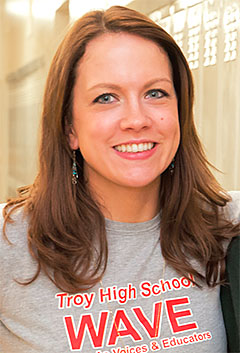
Kelly Comley, a member of the Troy Teachers Association, teaches English language arts at Troy High School. Through Women As Voices and Educators (WAVE), a student empowerment initiative, Comley and other educators at the urban high school work with students to change the culture of unacceptable behavior toward young women.
1. What do you believe are the biggest challenges students face today?
Despite the various benefits of social media, it is certainly detrimental to many of our students. I recently found a student in tears, and she told me that her life was ruined because of an embarrassing post put out to the cyber world by a supposed friend. Ruined! Girls are targeting girls. Boys are targeting girls, and it is as though the art of talking face to face and working through adversity has been long forgotten or never learned.
I have found that almost every student is affected by sexual abuse, domestic or relationship violence, mental or verbal abuse — either in their own life or through that of a friend, cousin, classmate. We strive to empower our students through discussion, activism and community.
2. Why did you start WAVE?
We started WAVE two years ago in response to the prevalence of derogatory language and actions directed toward young women that we were witnessing. The effect that such conflict has on our students' ability to learn and to develop is astounding. We created a group to challenge sexist, violent and oppressive behavior throughout the entire school year as opposed to one day of observation. Counselor Bruce Margolis and I had joined forces to organize the first observation of One Billion Rising (www.onebillionrising.org), a movement to stop violence against women, in Troy High School. The support we received was a clear indication that issues like sexual assault and domestic violence deeply affect our students.
3. How does involvement in WAVE make a difference?
Being a part of this group provides students with knowledge and prepares them to effectively deal with conflict. We encourage members to leave their role as bystanders and safely advocate for their own rights and the rights of others. This is a safe place for many members, a place where they can find strength and community.
4. How do you get students to join an organization about respect and make it relevant to them?
Students have an incredible amount of input. Bruce and I want to know what is difficult about being a teenager in today's society, so we ask. Our captains are encouraged to lead by example and come up with discussion topics and initiatives. Students have opportunities to counsel one another and share their experiences as teenagers in 2015. We often role-play so students FEEL the difference between talking about how to change things and HOW to do it. People are fearful of rejection, and of being harmed, so bystanding is often easier and perceived as safer. We assist practicing how to react. We have completed Mentors in Violence Prevention programs and have numerous community connections. I'd venture to say that it is difficult to not find something that you can relate to or that weighs on your heart when you are involved in WAVE.
5. Does WAVE help students impacted by poverty?
I do believe that groups like WAVE provide students with a support system and strategies to cope with their situations whether they be hunger, living with the power turned off, having no home, etc.